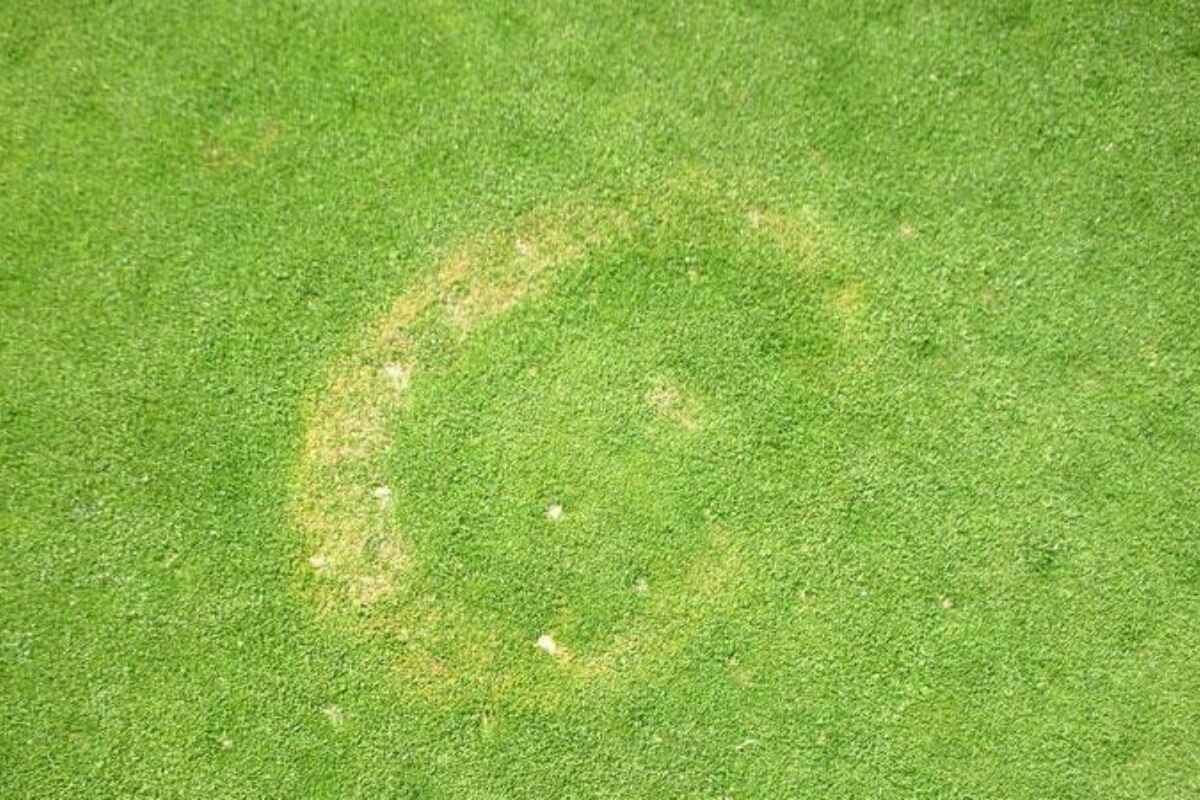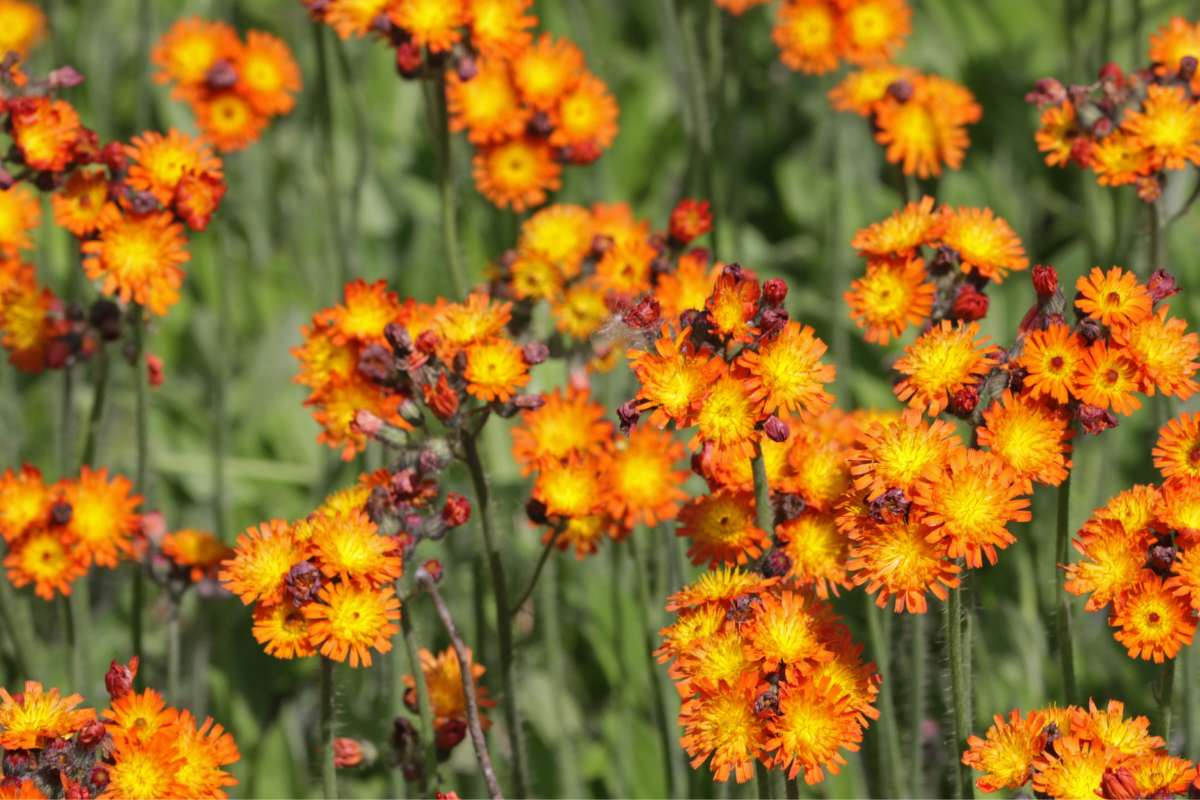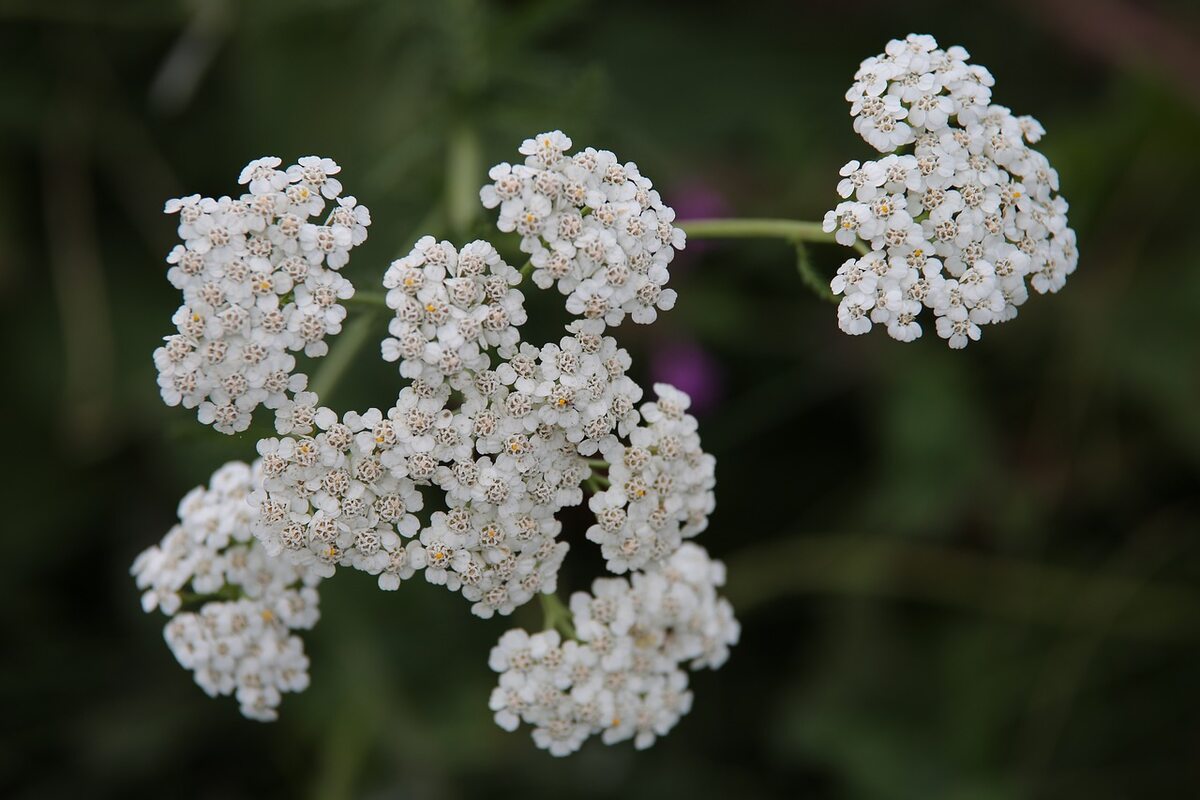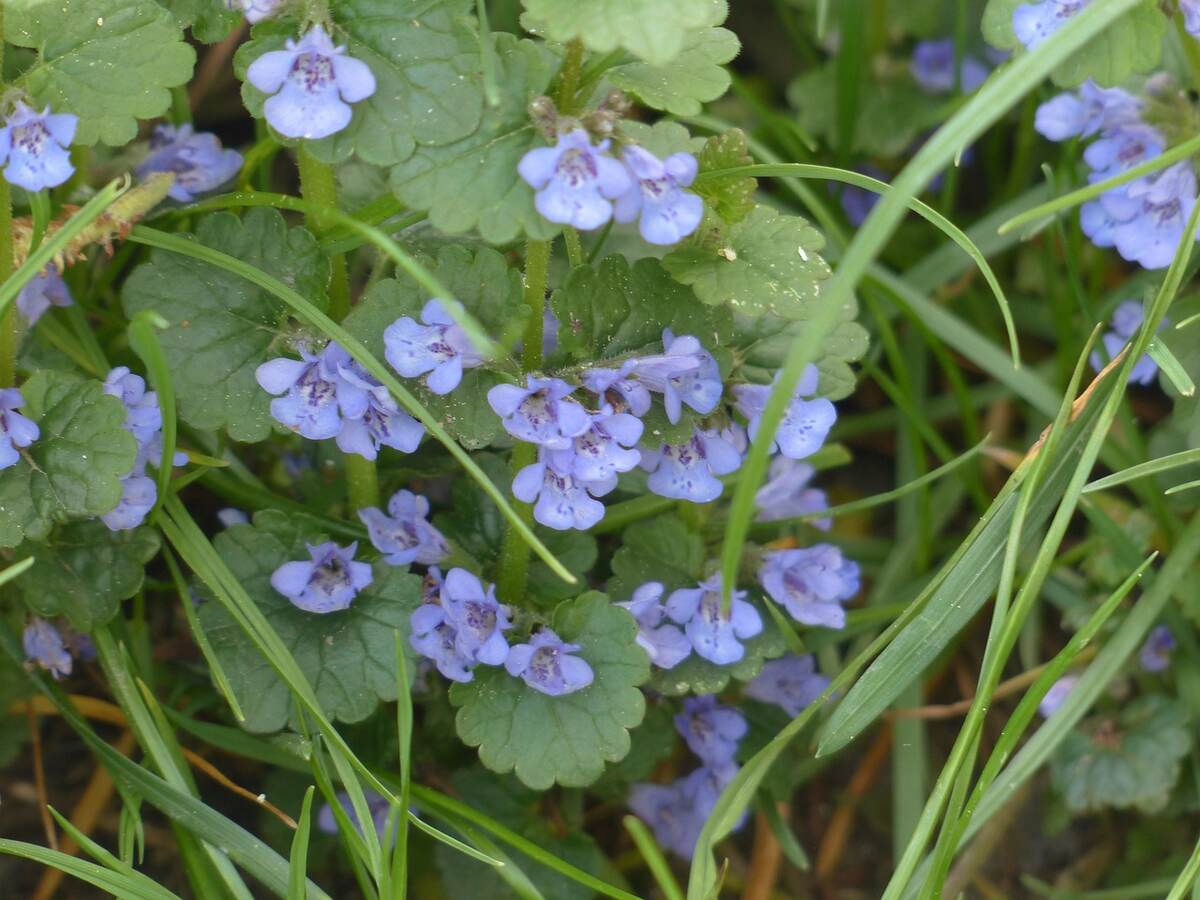
In the spring, millions of yellow flowers arrive on everyone’s lawn; they then transform into puffballs and are carried off by the wind like tiny fairies floating into the distance. Romantic as it may sound, homeowners groan, knowing that many other weeds will follow suit. Get familiar with these 11 common lawn weeds in Pennsylvania and how to identify and control them.
In this article, we’ll break down the weeds so you’ll know how to spot them and learn tips to control them. The weeds are divided into three categories: broadleaf, grass-like, and sedge. Let’s dive in.
Broadleaf Weeds
Dead Nettle (Lamium purpureum L.)
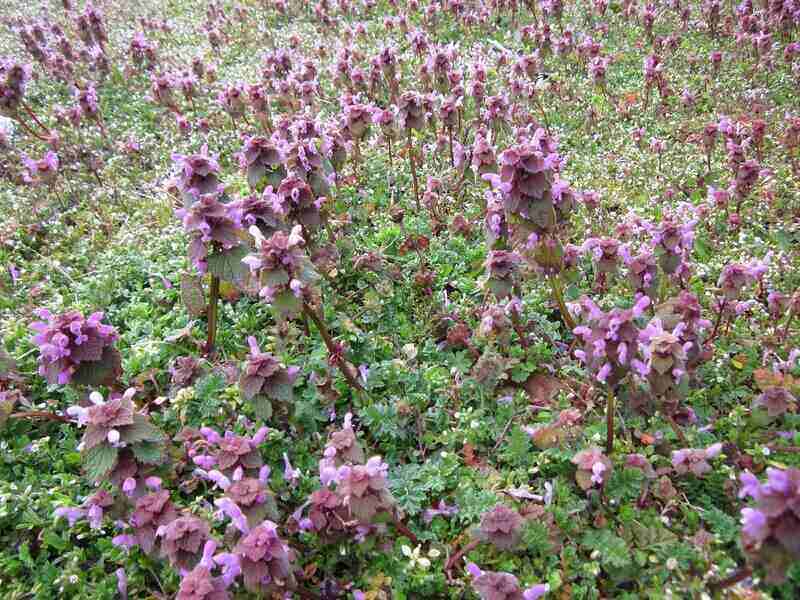
This winter annual, also known as purple dead nettle, is a member of the mint family and can be recognized by its square stem, fuzzy leaves, purple tops, and small, pink flowers. It typically grows in patches and can reach heights of 8-10 inches.
Despite its misleading name, dead nettle is not in the nettle family and doesn’t have the ability to sting or cause skin irritation.
Life cycle: Winter annual
Weed type: Broadleaf
Where it thrives: Full sun to moderate shade, moist soils
How To identify dead nettle: Dead nettle plants have upright stems with red and purple leaves and spread quickly to form patches. In April, they have pinkish-purple flowers.
How to get rid of dead nettle:
1) Pull out the entire fibrous root system by hand while the plant is young.
2) Mow frequently at a lawn height of 2 to 3 inches in early spring to remove the flower stems.
3) Apply pre-emergent herbicides in the fall to prevent dead nettle.
4) Apply post-emergent herbicides in the spring for weeds that have germinated.
Ground Ivy (Glechoma hederacea)
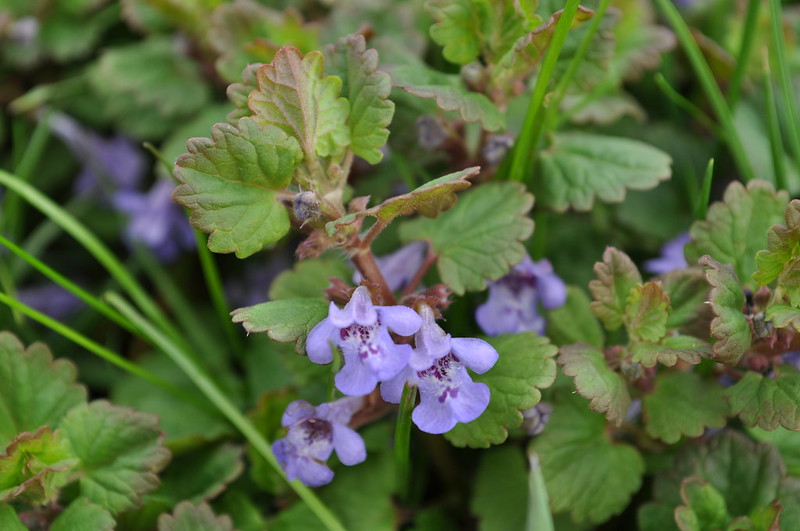
Ground ivy, also called gill-over-the ground, cat’s foot, and creeping Charlie, spreads by above-ground runners (stolons) that put down roots at each node where the leaf attaches to the stem. They can extend to 7 feet long. In late spring, leaf clusters of purple flowers appear.
Described as “plant velcro,” ground ivy makes pulling weeds by hand challenging due to the multiple attachment points.
Life cycle: Perennial (summer)
Weed type: Broadleaf
Where it thrives: Shade
How to identify ground ivy: Evergreen, heart-shaped leaves with delicate bluish-violet to lavender tubular flowers. The flowers are 0.4 in. (0.9 cm) long and appear in clusters of two or more.
How to get rid of ground ivy:
1) Pull roots by hand, but this can be difficult due to multiple attachment points.
2) Mow your lawn to a height of at least 3 inches and fertilize adequately (2 lbs. nitrogen per 1,000 sq. ft.).
3) Twice yearly: Apply a post-emergent broadleaf herbicide when flowers arrive in spring (March-May) and late fall (Sept-Nov) when the plant is actively growing. Do not apply in the summer.
Black Medic (Medicago lupulina L.)
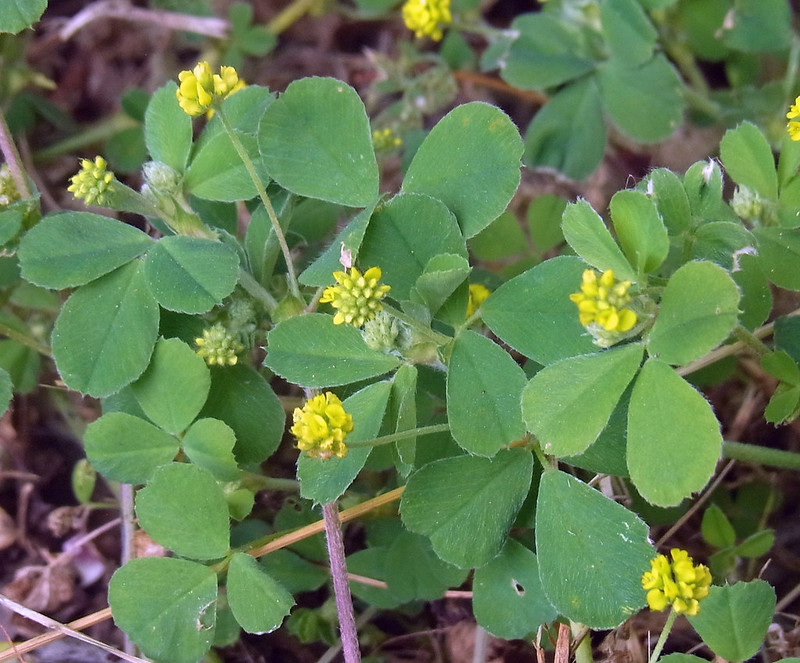
Black medic is a common summer weed that gets mistaken for clover or oxalis due to its heart-shaped leaves and yellow flowers. However, the center leaf of black medic has a slightly longer stem. As the plant matures, its yellow flowers become black seed pods, which is how it got its name.
Life cycle: Typically an annual (summer or winter), perennial in areas with mild winters
Weed type: Broadleaf
Where it thrives: Full sun, compact soils
How to identify black medic: Heart-shaped leaves like clover, black seed heads, and yellow flowers grow in clumps
How to get rid of black medic:
1) Pull roots by hand when the soil is wet.Do your best to pull the large taproot as well.
2) In the fall, aerate and overseed your lawn to create a dense turf that outcompetes these weeds.
3) Apply a pre-emergent herbicide.
4) Apply post-emergent herbicides. Options include dicamba, MCPP, and/or fluroxypyr, among others. Post-emergents work best when weeds are small but actively growing. This is in early to late spring for a summer annual or fall for a winter annual as they will more easily absorb the weed killer.
Spotted Spurge (Chamaesyce maculata L.)
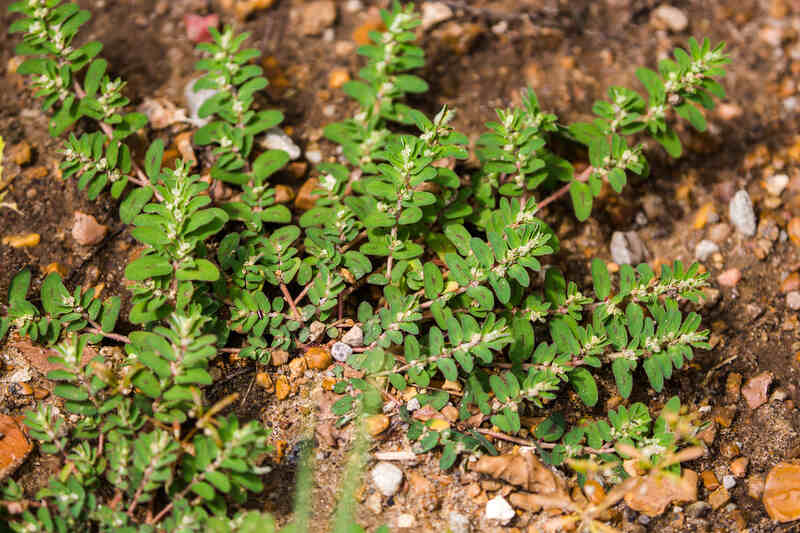
Spotted spurge, also known as spotted euphorbia, spotted sandmat, milk-purslane, and prostrate spurge, is a pesky weed that grows in clusters. This weed spreads out from a central growing point and lays flat along the ground. Spotted spurge is recognizable by its red, fuzzy stems and small, oval-shaped leaves.
Spotted spurge thrives in lawn areas that have compacted soils and bald spots. Be careful of its sticky seeds that attach to animal fur, shoe soles, and the tires of lawnmowers. It also has a sticky, milky substance in the stems that can irritate the skin.
Life cycle: Annual (summer)
Weed type: Broadleaf
Where it thrives: Full sun or partial shade, loves poor, compacted soil
How to identify spotted spurge: Lays flat along the ground. It has red, fuzzy stems; small, oval-shaped leaves with a red spot in the center; and white and pink flowers.
How to get rid of spotted spurge:
1) The best way to control spurge is to prevent germination by mulching and removing plants as soon as they are noticed.
2) Hand-pull or hoe out the weeds, preferably before they produce seeds. Note: Wear gloves when hand-pulling these weeds.
3) Pre-emergent herbicides should be applied before the soil temperature exceeds 60ºF and before seeds have sprouted.
Broadleaf Plantain (Plantago major)
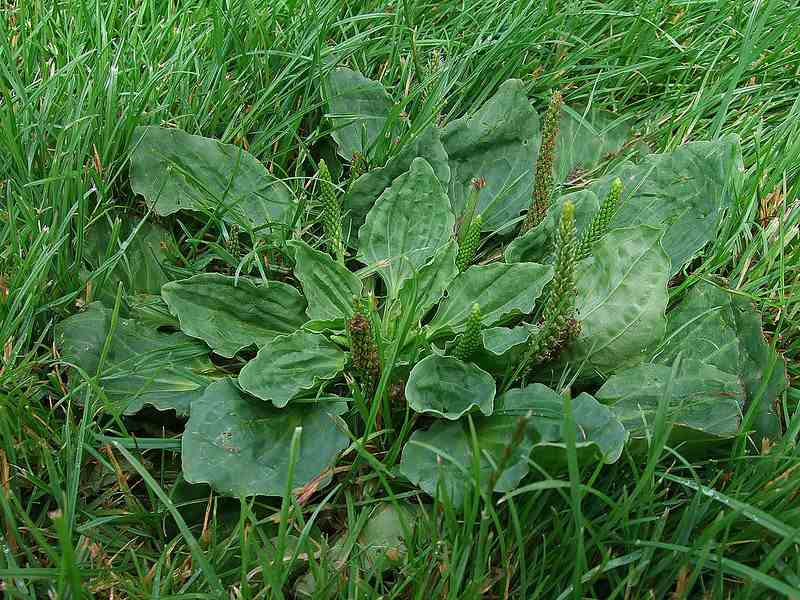
Broadleaf plantain, also known as white man’s footprint, waybread, or greater plantain, is a common weed found in lawns, gardens, and along roadsides. Its leaves are oval-shaped, dark green, and grow close to the ground. The leaf edges are wavy, with three to five parallel veins.
The plant produces flowers on tall spikes and can produce up to 14,000 seeds annually. Despite being considered a weed, broadleaf plantain has been used for medicinal purposes for centuries and is known for its anti-inflammatory and wound-healing properties.
Life cycle: Perennial (summer)
Weed type: Broadleaf
Where it thrives: Prefers sun but can adapt to shady conditions; loves neglected, compacted, and soggy soil
How to identify broadleaf plantain: Its leaves are dark green and egg-shaped, growing close to the ground. The leaves are smooth with wavy edges, 3-7 inches long and 1-2 inches wide and have three to five parallel veins. The plant produces flowers on long, narrow spikes.
How to get rid of broadleaf plantain:
2) Apply pre-emergents (examples include isoxaben, flumioxazin, and indaziflam) to limit the growth of plantain seedlings.
3) Applying post-emergent spot treatment with nonselective, systemic herbicides like glyphosate can control plantains.
Dandelions (Taraxacum sp.)
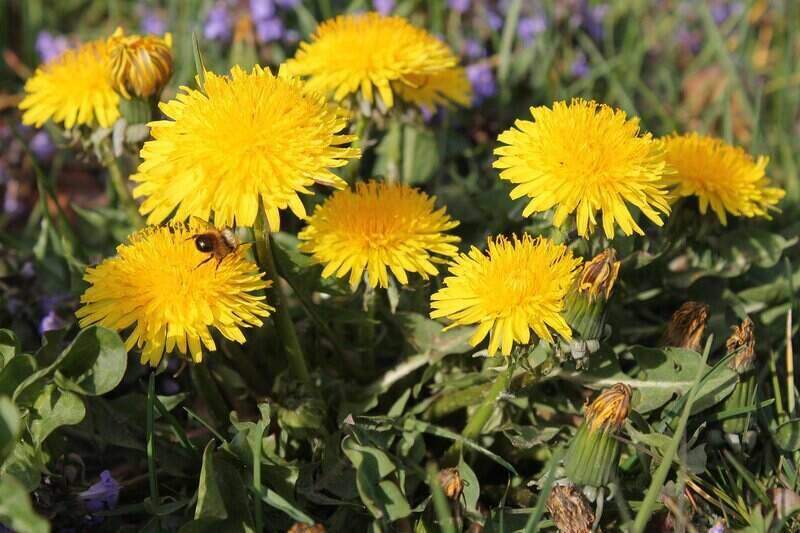
In the spring, dandelions produce bright yellow flowers about an inch in diameter atop long stems. The leaves are long, narrow, have deep lobes, and form a rosette. Dandelions have thick taproots that can reach several inches into the soil.
Following the yellow flowers, dandelion seed puffballs will form. Each seed is equipped with a unique mechanism for dispersal — a parachute-like structure called a pappus. This structure comprises numerous filaments that enable the seed to be carried away by the wind, allowing for widespread plant distribution.
Life cycle: Perennial (spring)
Weed type: Broadleaf
Where it thrives: Full sun, adapts to any soil
How to identify dandelions: Flat yellow flowers appear first in the spring. The flowers then transform into seed puffballs carried individually by the wind.
How to get rid of dandelions:
1) Dandelions have a deep taproot that makes hand-pulling difficult. Mulch can be used as a non-chemical option in flower beds. Mowing the lawn regularly also prevents seed heads from forming.
2) Apply pre-emergent herbicides in early spring before the weeds germinate.
3) Or use post-emergent herbicides in late summer or early fall to be most effective. Common options contain 2, 4-D, florasulam (Defendor); metsulfuron; or triclopyr + clopyralid (Confront).
Yellow Woodsorrel (Oxalis stricta)
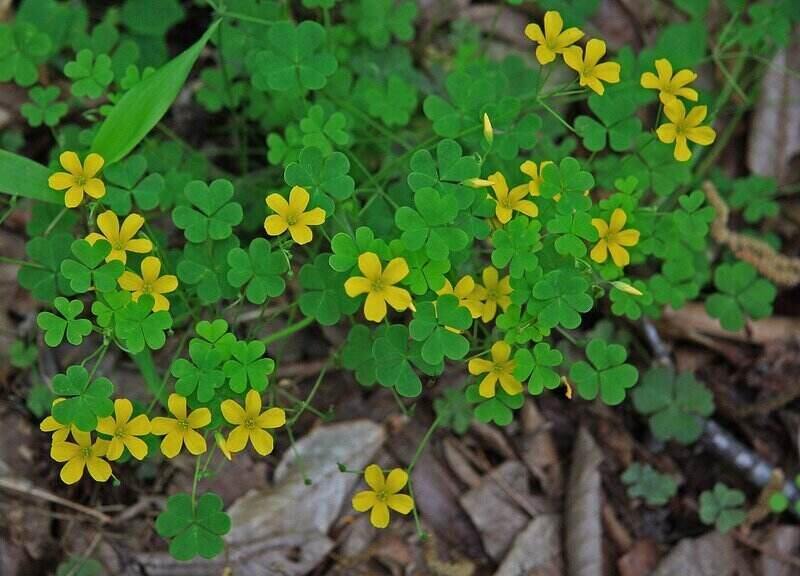
Yellow woodsorrel, also called summer grass, sheep’s clover, shamrock, and sleeping beauty resembles clover. Its heart-shaped green leaves turn burgundy in the summer, producing yellow flowers.
This pesky weed is a perennial or annual that can thrive in both shade and sun, and it is notorious for its ability to take over lawns quickly. This is also one of the most difficult broadleaf weeds to control in the area.
Tip: When distinguishing between clover and oxalis, the shape and color of the leaves are key factors. While clover has oval-shaped leaves, oxalis has small, light green leaves that are heart-shaped.
Life cycle: Annual and Perennial (summer)
Weed type: Broadleaf
Where it thrives: Prefers full sun but will tolerate shady areas. Prefers moist, fertile soil, but will adapt to various soils
How to identify yellow woodsorrel: Look for three small, light-green, heart-shaped lobes on each leaf. White bell-shaped flowers that appear in mid-spring, and thin purple veins running along the petals.
How to get rid of yellow woodsorrel:
1) Discourage growth: Fertilize, mow regularly, and grow a dense lawn by using one of the best grasses for Pennsylvania
2) Hand-pull or dig out all rhizomes and roots before they flower or form seeds
3) Apply preemergence herbicides: Dithiopyr, isoxaben, oryzalin, and prodiamine are a few examples of common pre-emergents.
4) Apply post-emergent herbicides. Some prefer to apply those containing combinations of 2,4-D, dicamba, MCPP, and/or fluroxypyr, as well as herbicides containing triclopyr.
Bull Thistle (Cirsium vulgare)
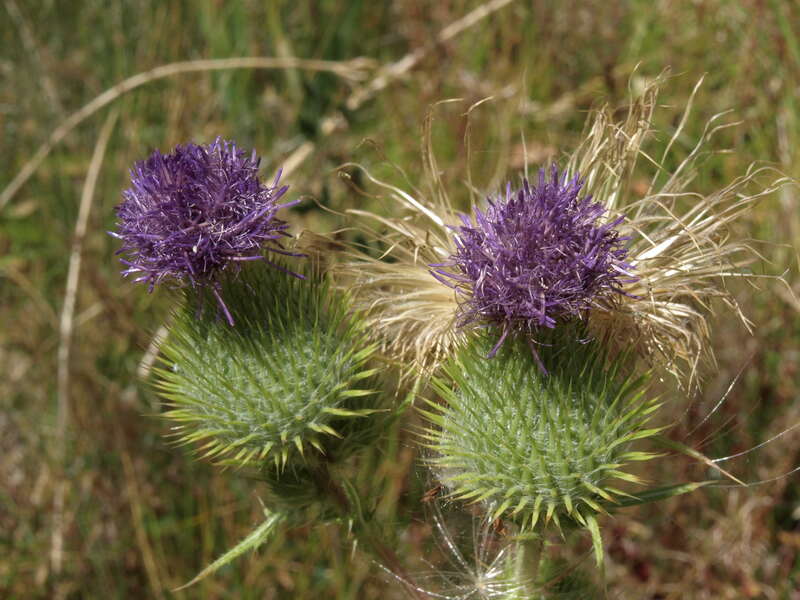
A member of the Aster family, this prickly weed can grow anywhere between 2-6 feet tall. In its first year of growth, it forms a rosette. The following year produces the spine-covered, upright stems that hold large, reddish-purple flower heads measuring 1.5-2.5 inches in width.
It blooms from June to October. The prickly wings on the stem at the base of the leaves are formidable. It is a useful plant to bees, butterflies, and the early herbalists who are said to have used it to treat varicose veins.
Note: Bull thistle can reproduce only from seeds that germinate in the spring.
Life cycle: Annual or Biennial
Weed type: Broadleaf
Where it thrives: Full sun, thrives best in nitrogen-rich soil with moderate moisture
How to identify bull thistle: Erect, upright flowering stalks with pink to reddish-purple flowers. Rosette at the plant base. Long, sharp spines on leaves at midrib and tips of lobes. Can grow anywhere between 2 to 6 feet tall.
How to get rid of bull thistle:
1) Hand pull the weed, but be aware the taproot goes deep.
2) Regular mowing will prevent the plant from developing flowers.
3) Pre-emergent herbicides can be used in landscapes and turf. A commonly used pre-emergent is Dithiopyr (Dimension).
4) Post-emergent herbicides are another option. Common products include clopyralid (Lontrel), diquat (Reward) and glyphosate (Roundup).
White Clover (Trifolium repens L.)
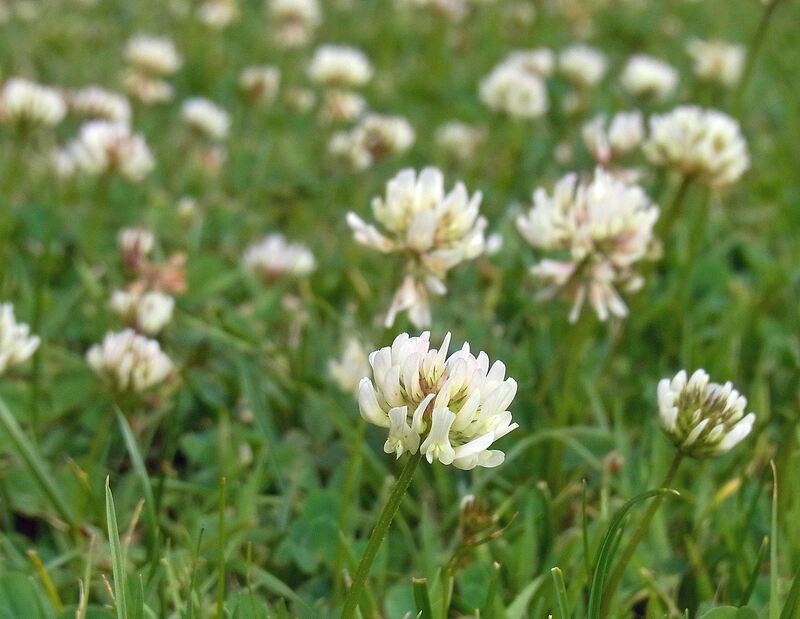
White clover grows in patches close to the ground and can be identified by its three oval leaflets (1/4 to 3/4 inches in diameter). Each leaflet has a white or light green inverted V-shape pattern called a watermark. In early spring, white flowers tinged with pink appear.
This hardy weed thrives in the spring, summer, and fall. Flowers emerge during late spring and early summer. Occasionally, you’ll find a leaf with four leaves (the lucky four leaf clover).
Life cycle: Perennial (spring, summer, and fall)
Weed type: Broadleaf
Where it thrives: Prefers full sun but can grow in shade with proper fertilization; well-drained, fertile soil with a pH of 6-7
How to identify white clover: Three small, oval leaflets; grows in patches close to the ground, and has white flowers tinged with pink that appear in early spring.
How to get rid of white clover:
1) Improve turf density with good establishment procedures, and use well-adapted turfgrass.
2) Fall applications of herbicides are often the most effective means of controlling white clover. These herbicide products include: dicamba, clopyralid, fluroxypyr, and quinclorac.
Note: Regrowth of foliage sometimes occurs following spring herbicide applications.
Grass-Like Weed
Crabgrass (Digitaria)
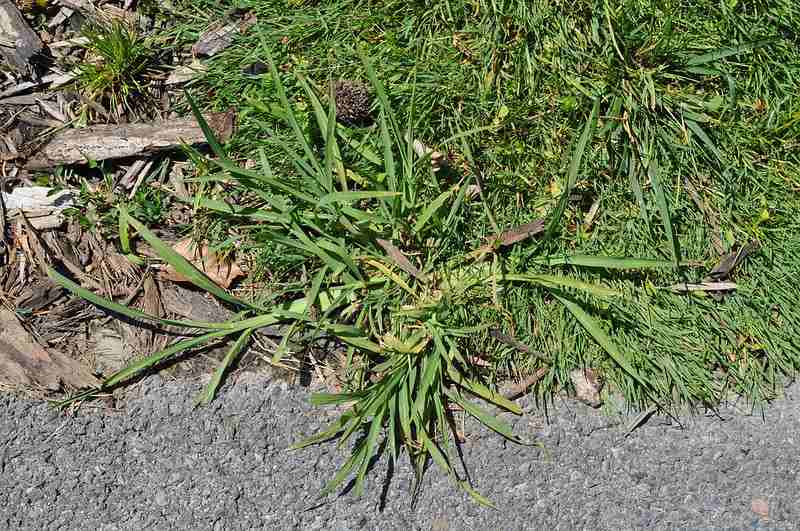
Crabgrass is recognizable by its light green appearance and sprawling stems that resemble crab legs. It typically grows in clumps (a prostrate growth habit in which lower stems branch out and spread across the ground) but can grow up to 2 feet tall.
There are two species of crabgrass in Pennsylvania — smooth and large. You can tell the difference by getting up close to see the hairs on the leaves and stem. Large crabgrass has more hairs, while smooth crabgrass has almost none.
Life cycle: Annual (summer)
Weed type: Grass-like
Where it thrives: Full sun, thinned-out sections of lawn, grows in all soils
How to identify crabgrass: Look for it in the summer; it has a light green color and clumpy, crab-like, leggy stems.
How to get rid of crabgrass:
1) Prevention: Improve turf with fertilization, irrigate during dry conditions, and use turfgrasses that are well-adapted to site conditions
2) Mow on a regular basis, making sure grass stays about 3 inches high
3) Apply a pre-emergent herbicide in the spring before the seeds sprout.
Note: In Pennsylvania, crabgrass seeds start germinating when the top inch of soil reaches 55-58 degrees Fahrenheit.
4) Apply a post-emergent: If crabgrass has already taken hold, spot spraying with a targeted herbicide throughout the summer can help to eliminate it without harming surrounding plants.
Sedge Weed
Yellow Nutsedge (Cyperus esculentus)
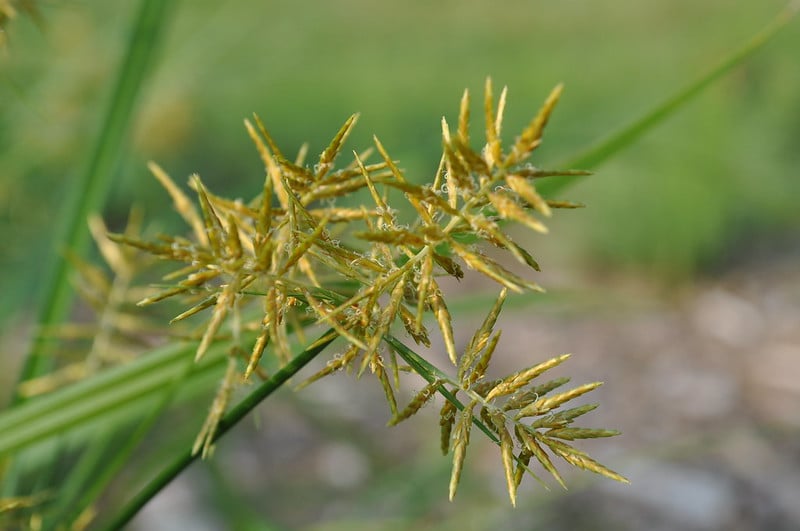
Photo credit: NY State IPM Program at Cornell University / Flickr / CC BY 2.0
This pesky weed announces its entrance with distinct yellow-green leaves and seed heads that resemble miniature bottle brushes (0.5 to 1.25 inches long). In the summer heat, it grows faster and taller (8-30 inches tall) than the cool-season grass in your lawn.
Yellow nutsedge reproduces by two types of underground, nut-like tubers. One type germinates immediately, and the other one germinates during the winter. It also has quite an extensive underground network of roots and rhizomes.
Note: Yellow nutsedge goes by many names: nutgrass, yellow nut-grass, chufa, nutsedge, watergrass, northern nut-grass, earth almond, rushnut, umbrella sedge, and galingale.
Life cycle: Perennial (Emerges in the spring, flowers in the summer, and sets seed late summer to fall.)
Weed type: Sedge
Where it thrives: Prefers full sun and moist, poorly drained soil
How to identify yellow nutsedge: It has a distinct yellow color, triangular (three-edged) stem, and grows taller than turfgrass.
How to get rid of yellow nutsedge:
1) Hand-pull emerging leaves early and often if the patch is small.
Note: Remember, this weed is a sedge! Herbicides for broadleaf and grass-like weeds won’t work on this one. The best time to apply an herbicide is in late spring or early summer during the active growing season.
2) Consider applying sulfentrazone or halosulfuron in late spring or early summer. Read the instructions on the labels.
FAQ
Yes, they are called “indicator plants.” Here are a few indicator plants that indicate what’s happening with your soil.
Dead nettle: Acidic soil
Black medic: This indicates moist, poorly-drained soils; high in magnesium, low in calcium
Spotted spurge (purslane): This indicates moist, poorly-drained soils; high in magnesium, low in calcium
Dandelion: Acidic soils with high potassium levels and low calcium levels
Yellow woodsorrel: Soil is compacted and less fertile, sometimes too wet
White clover: Compacted, acidic soil or low nitrogen levels
Crabgrass: High levels of potassium, magnesium; low levels of phosphorus and calcium and a low pH
Broadleaf weeds have three unique life cycles, which affect how they should be controlled and removed. Understanding these life cycles is crucial in effectively managing these pesky plants.
1. Annuals
Annual weeds are known for their ability to produce many seeds, but they are also the easiest type of weed to manage due to their uncomplicated root system. Annual weeds can be categorized into two types: winter and summer.
Winter annuals sprout in the fall or winter, survive through the cold months, and bloom in the winter or spring.
Summer annuals germinate in spring and complete their life cycle during the warm months of the year.
Note: Regardless of their type, annual weeds live only for a year before dying off.
2. Biennials
Biennial weeds are plants that take two years to complete their life cycle:
The plant establishes its root system during the first year and grows stems and leaves. Then it goes dormant during the winter months.
The plant produces flowers and seeds in the second year before eventually dying off. Some biennial weeds can last up to five years before completing their life cycle.
3. Perennials
Perennial weeds come back year after year. These weeds can grow from seeds or their extensive root systems. Perennial weeds are a constant battle for Pennsylvania homeowners.
Yes. There is one common weed that is also a Pennsylvania native: common yellow woodsorrel. Gardeners find controlling them a challenge. Growing a full, dense lawn is one of the best methods to control yellow woodsorrel, especially if you prefer to grow a chemical-free lawn.
Call In The Pros
If the weed battle is getting you down, hand the fight over to the Lawnstarter lawn care pros in your area. Many lawn care pros exist in Philadelphia, Pittsburgh, Allentown, Harrisburg, and throughout Pennsylvania. They can diagnose, treat, and get rid of these pesky weeds.
Main Image Credit: Pixabay


